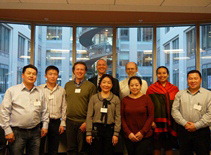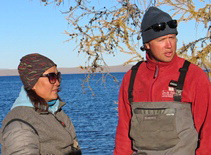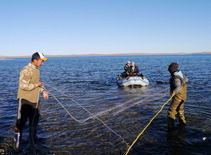The research team assessed the seasonal pattern of lake turnover and stratification. They determined how the timing of these events corresponds to the air temperature and weather events through deployment of thermistor strings in the lake, which recorded an entire year of water temperature measurements every fifteen minutes at four depths. These observations represent a significant advance in the study of Lake Hovsgol, as water temperature at this lake depth had never been monitored before for more than a few weeks at a time.
During the course of the project, the research team also observed special distribution of fish, specifically, Hovsgol grayling and their zooplankton prey seasonal change in response to the changing temperatures. Spatial temperature variation within the river on daily and seasonal time scales was measured as well. The extent to which the variability of air temperatures influences water temperature and the flow in the Eg-Uur Rivers and the movement of tagged Taimen was measured as well. Further information about the project can be accessed on the web at
http://maaeri.weebly.com/.
Mongol Ecology Center (MEC), which served as the institutional manager for this project, established the Lake Hovsgol Conservancy in order to partner with the protected area administration, local governments, commercial service providers and local citizens. The research team has been working with the community members of the Khankh and Hatgal village (north and south of Lake Hovsgol), district government officials, director and staff of Specially Protected Area Department at the Ministry of Environment and Green Development, and with Park Administration staff and rangers. The findings of their research are being shared with the stakeholders to raise awareness in Lake Hovsgol and in efforts to apply them in park planning management. The research team also held several workshops to training Mongolian students and conservation rangers in field ecology techniques.
PublicationsP. Tsogtsaikhan, B. Mendsaikhan, G. Jargalmaa, B. Ganzorig, B. C. Weidel, C. M. Filosa, C. M. Free, T. Young, O. P. Jensen. 2017. Age and growth comparisons of Hovsgol grayling (
Thymallus nigrescens Dorogostaisky, 1923), Baikal grayling (
T. baicalensis Dybowski, 1874), and lenok (
Brachymystax lenok Pallas, 1773) in lentic and lotic habitats of Northern Mongolia.
Journal of Applied Ichthyology 33(1): 108-115. https://doi.org/10.1111/jai.13247
Christopher M. Free, Olaf P. Jensen, Bud Mendsaikhan. 2015. A Mixed-Method Approach for Quantifying Illegal Fishing and Its Impact on an Endangered Fish Species.
PLoS One 10(12): e0143960.
https://doi.org/10.1371/journal.pone.0143960
Christopher M. Free, Olaf P. Jensen., Sherri A. Mason., Marcus Erikser., Nicolas J. Williamson., Bazarsad Boldgiv. 2014. High levels of microplastic pollution in a large, remote,
mountain lake.
Marine Pollution Bulletin 85(1): 156-163.
https://doi.org/10.1016/j.marpolbul.2014.06.001B. Mendsaikhan, E. Tengis, P. Tsogtsaikhan, B. Ganzorig, G. Jargalmaa, Ch. Chantuu, B. Menkhzorig. 2014. Fisheries and Fish Farmers in Mongolia.
Geoecological Issues in
Mongolia. Ulaanbaatar.
B. Onodelgerekh, B. Mendsaikhan, Olaf P. Jensen. 2014. Fish study at the Lake Hovsgol.
Newsletter of the Mongol Ecology Center.
B. Mendsaikhan, B. Ganzorig, G. Jargalmaa, Ch. Chantuu, B. Menkhzorig. 2014. Embryonic study of the Lenok (
Brachymystax lenok).
Geoecological Issues in Mongolia.
Ulaanbaatar.






